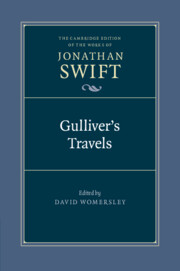Book contents
- Frontmatter
- Contents
- List of Illustrations
- General Editors’ Preface
- Acknowledgements
- Chronology of Swift’s Life
- Chronology of Gulliver’s Travels
- List of Abbreviations
- Introduction
- Gulliver’s Travels
- A Letter From Capt. Gulliver, to His Cousin Sympson
- The Publisher to the Reader
- The Contents
- Part I
- Part II
- Part III
- Part IV
- Long Notes
- Appendices
- Textual Introduction
- Select Bibliography
- Index
Textual Introduction
Published online by Cambridge University Press: 02 September 2021
- Frontmatter
- Contents
- List of Illustrations
- General Editors’ Preface
- Acknowledgements
- Chronology of Swift’s Life
- Chronology of Gulliver’s Travels
- List of Abbreviations
- Introduction
- Gulliver’s Travels
- A Letter From Capt. Gulliver, to His Cousin Sympson
- The Publisher to the Reader
- The Contents
- Part I
- Part II
- Part III
- Part IV
- Long Notes
- Appendices
- Textual Introduction
- Select Bibliography
- Index
Summary
The history of the text
Early drafts and the manuscript
Although there are grounds for speculating about the origins in conversations amongst the Scriblerians during the 1710s of some of the material which would eventually be worked up and incorporated into Gulliver's Travels, the first certain reference to the book which would become Gulliver's Travels occurs no earlier than the spring of 1721. On 15 April Swift wrote to Charles Ford, the friend whom he had used some years before as a gobetween in connection with his publishing ventures, announcing that ‘I am now writing a History of my Travells, which will be a large Volume, and gives Account of Countryes hitherto unknown.’ It is not clear from this wording whether or not Ford knew of Gulliver's Travels before 1721 (and the phrase ‘my Travells’ indicates that the book was not known by that name even to Swift himself at this stage). The general explanation offered by Swift of what the book would contain perhaps suggests that Ford had no prior knowledge. However, it is clear that by late 1721 the project of the book which would become Gulliver's Travels was known and discussed amongst some of Swift's friends, although as yet no one apart from Swift seems to have been aware of its full scope. On 1 January 1722 Bolingbroke expressed a longing to read ‘yr travels’, and in June of that year Esther Vanhomrigh alluded unmistakably to an episode in Part II in a letter to Swift, while at the same time using language which evokes Part IV.
After those references and allusions Swift's correspondence is silent concerning Gulliver's Travels until the important letter to Ford of 19 January 1724, in which Swift states that ‘I have left the Country of Horses, and am in the flying Island, where I shall not stay long, and my two last Journyes will be soon over.’ This revelation that at least the final revision of the text of Part III occurred after the completion of the text of Part IV is the only certain information we possess about the internal history of the composition of Gulliver's Travels.
- Type
- Chapter
- Information
- Gulliver's Travels , pp. 627 - 774Publisher: Cambridge University PressPrint publication year: 2012

